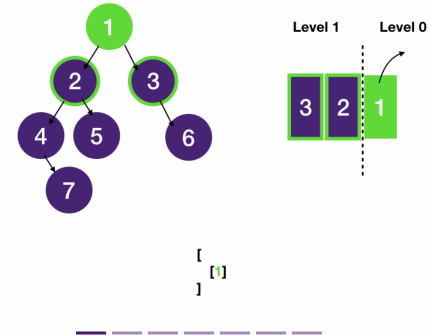Breadth First Search: BFS On Tree
Binary Tree Level Order Traversal
Given a binary tree, return its level order traversal.
Input is the root node of the tree.
The output should be a list of lists of integers, with the ith list containing the values of nodes on level i, from left to right.
Example:
lvl 0 -------- 1
/ \ [
lvl 1 ------ 2 3 [1],
/ \ \ -> [2, 3],
level 2 -- 4 5 6 [4, 5, 6],
\ [7],
level 3 ---- 7 ]
class Node {
constructor(val, left = null, right = null) {
this.val = val;
this.left = left;
this.right = right;
}
}
function levelOrderTraversal(root) {
if(!root) return [];
let result = [];
let queue = [root]; // at least one element in the queue to kick start bfs
while (queue.length > 0) { // as long as there is element in the queue
const n = queue.length; // number of nodes in current level, see explanation above
const newLevel = [];
for (let i=0; i<n; i++) { // dequeue each node in the current level
const node = queue.shift();
newLevel.push(node.val);
// enqueue non-null children
for (const child of [node.left, node.right]) {
if (child) queue.push(child);
}
}
result.push(newLevel);
}
return result;
}
Explanation

- We can use DFS for this problem by keeping track of the depth for each node.
- A better way though is to use BFS since BFS traverse the tree by level by default.
- Applying the template, we use a queue to keep track of nodes to visit next.
How to get a node's level
- When we dequeue a node from the queue, we need to know the level it sits in the tree to add it to the corresponding level in the result.
- But nodes in the queue do not have any information about level.
- How do we get a node's level?
- One observation is that the queue contains at most two levels of nodes.
- To see why let's assume our tree is three-level deep.
- Let's call the nodes of the shallowest level "level 0" nodes and their children "level 1" nodes, whose children are "level 2" nodes.
- When we do a BFS, we first push "level 0" nodes into the queue, and as we process them, we push their children "level 1" nodes into the queue.
- To get "level 2" nodes onto the queue,
- we have to start dequeuing and processing "level 1" nodes
- but we can't dequeue any "level 1" nodes until we have finished dequeuing and processing "level 0" nodes
- since a queue is a First-in-First-Out structure.
- Therefore it's impossible to have 3 levels in the queue at the same time, and we can have at most two levels in the queue.
- Also, observe that we always push the leftmost node of a level into the queue first.
- When we dequeue the leftmost node (and before we add its children), the queue contains only one level of nodes.
- We can save the number of nodes in the queue in a variable n, and dequeue the next n nodes.
- One observation is that the queue contains at most two levels of nodes.
- Time Complexity:
O(n)- We traverse every edge and node once but since the number of edges is n - 1, then this simply becomes O(n).